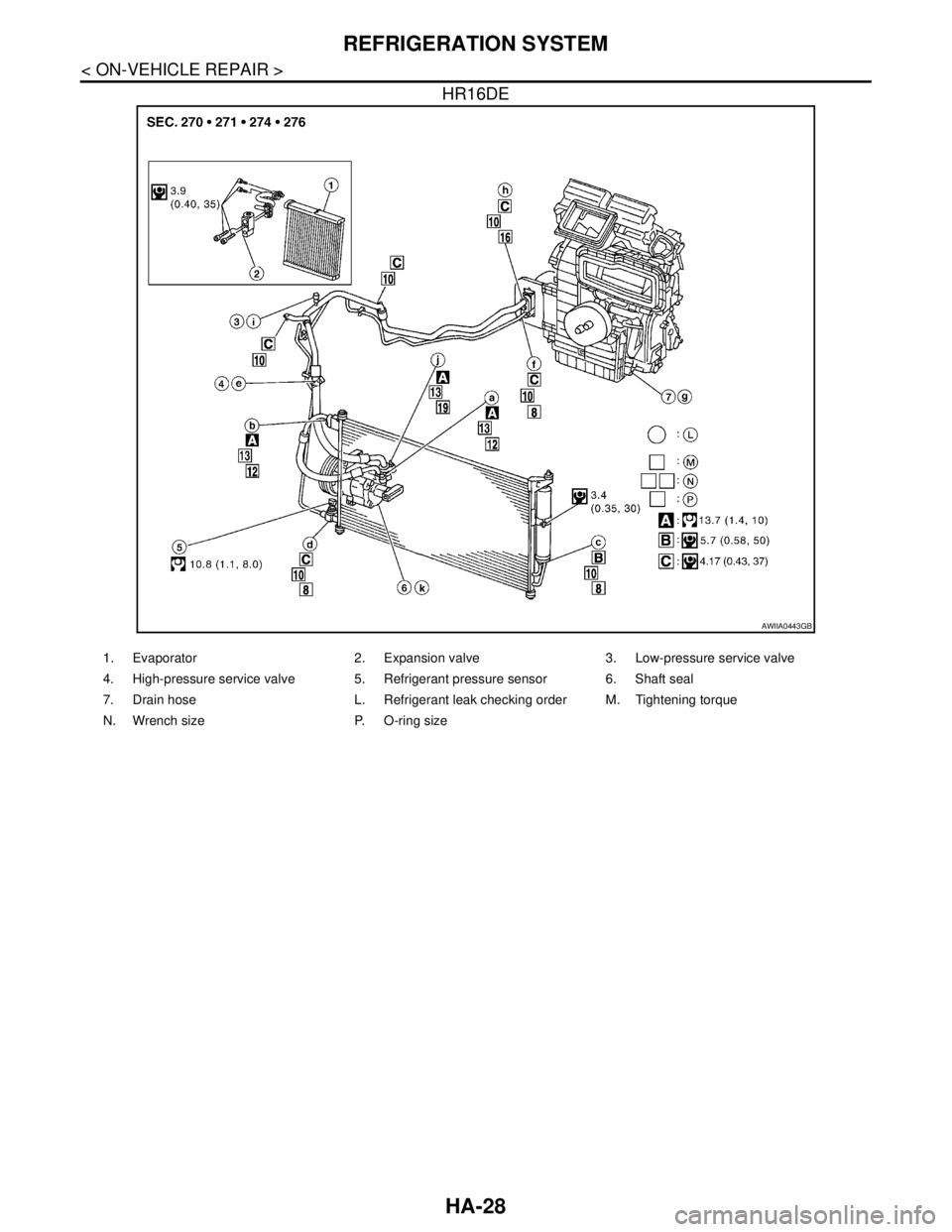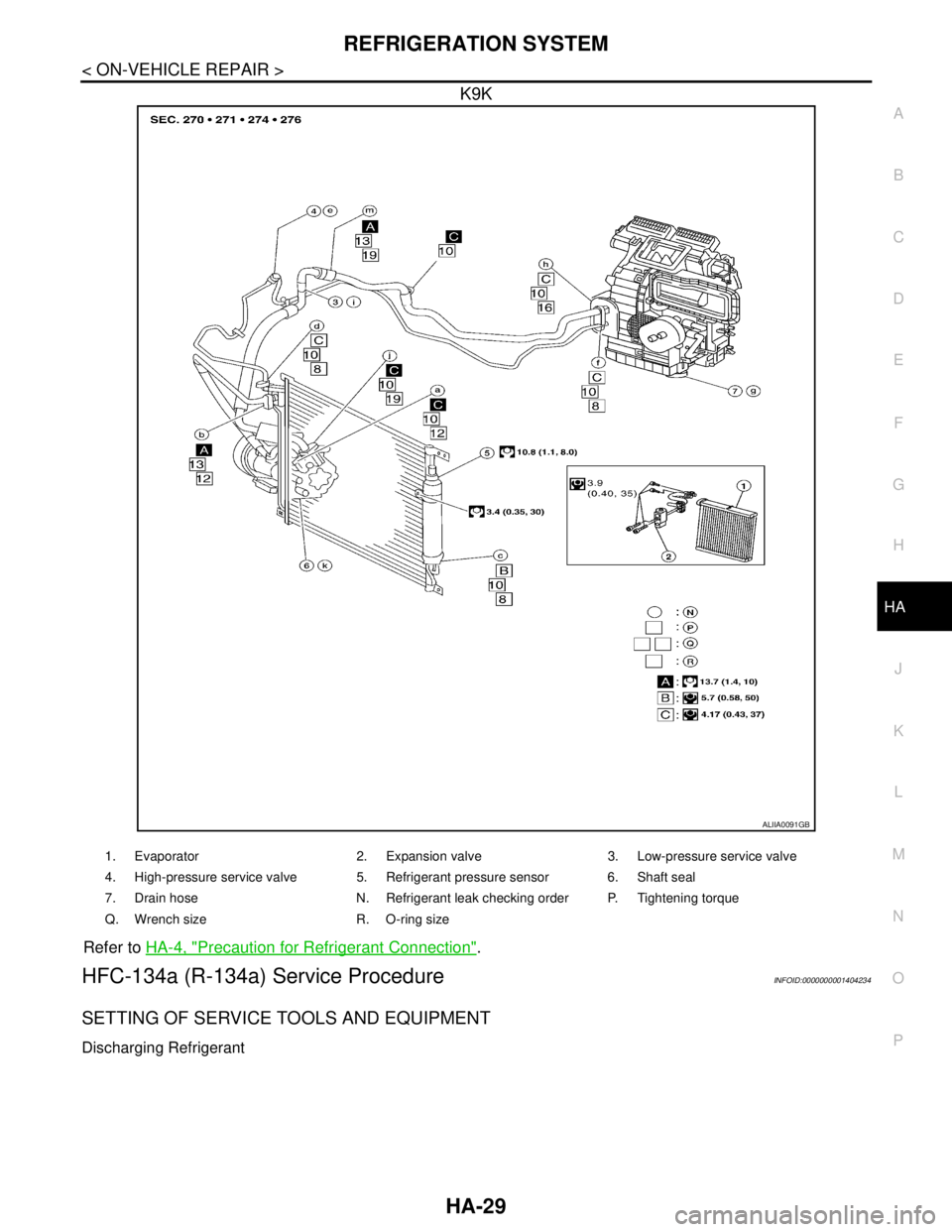2007 NISSAN TIIDA Evaporator sensor
[x] Cancel search: Evaporator sensorPage 3310 of 5883

HA-28
< ON-VEHICLE REPAIR >
REFRIGERATION SYSTEM
HR16DE
AWIIA0443GB
1. Evaporator 2. Expansion valve 3. Low-pressure service valve
4. High-pressure service valve 5. Refrigerant pressure sensor 6. Shaft seal
7. Drain hose L. Refrigerant leak checking order M. Tightening torque
N. Wrench size P. O-ring size
Page 3311 of 5883

REFRIGERATION SYSTEM
HA-29
< ON-VEHICLE REPAIR >
C
D
E
F
G
H
J
K
L
MA
B
HA
N
O
P
K9K
Refer to HA-4, "Precaution for Refrigerant Connection".
HFC-134a (R-134a) Service ProcedureINFOID:0000000001404234
SETTING OF SERVICE TOOLS AND EQUIPMENT
Discharging Refrigerant
ALIIA0091GB
1. Evaporator 2. Expansion valve 3. Low-pressure service valve
4. High-pressure service valve 5. Refrigerant pressure sensor 6. Shaft seal
7. Drain hose N. Refrigerant leak checking order P. Tightening torque
Q. Wrench size R. O-ring size
Page 3363 of 5883
![NISSAN TIIDA 2007 Service Repair Manual HAC-30
< COMPONENT DIAGNOSIS >[MANUAL AIR CONDITIONER]
INTAKE SENSOR
INTAKE SENSOR
Component InspectionINFOID:0000000001675415
COMPONENT DESCRIPTION
Intake Sensor
The intake sensor (1) is located on t NISSAN TIIDA 2007 Service Repair Manual HAC-30
< COMPONENT DIAGNOSIS >[MANUAL AIR CONDITIONER]
INTAKE SENSOR
INTAKE SENSOR
Component InspectionINFOID:0000000001675415
COMPONENT DESCRIPTION
Intake Sensor
The intake sensor (1) is located on t](/manual-img/5/57395/w960_57395-3362.png)
HAC-30
< COMPONENT DIAGNOSIS >[MANUAL AIR CONDITIONER]
INTAKE SENSOR
INTAKE SENSOR
Component InspectionINFOID:0000000001675415
COMPONENT DESCRIPTION
Intake Sensor
The intake sensor (1) is located on the A/C unit. It converts tempera-
ture of air after it passes through the evaporator (2) into a resistance
value which is then input to the BCM.
Intake Sensor Diagnosis ProcedureINFOID:0000000001675416
DIAGNOSTIC PROCEDURE FOR INTAKE SENSOR
SYMPTOM: Intake sensor circuit is open or shorted.
1.CHECK VOLTAGE BETWEEN INTAKE SENSOR AND GROUND
1. Turn ignition switch OFF.
2. Disconnect intake sensor connector.
3. Turn ignition switch ON.
4. Check voltage between intake sensor harness connector M42
terminal 1 and ground.
OK or NG
OK >> GO TO 2.
NG >> GO TO 4.
2.CHECK CIRCUIT CONTINUITY BETWEEN INTAKE SENSOR AND BCM
ZJIA0798J
AWIIA0452GB
Te r m i n a l s
Vo l ta g e
(Approx.) (+) (−)
Connector Terminal
Ground
Intake sensor: M42 1 5V
SJIA0825E
Page 3472 of 5883
![NISSAN TIIDA 2007 Service Repair Manual INTAKE SENSOR
HAC-139
< COMPONENT DIAGNOSIS >[AUTO AIR CONDITIONER (W/O NAVI)]
C
D
E
F
G
H
J
K
L
MA
B
HAC
N
O
P
INTAKE SENSOR
Component InspectionINFOID:0000000001572418
COMPONENT DESCRIPTION
Intake S NISSAN TIIDA 2007 Service Repair Manual INTAKE SENSOR
HAC-139
< COMPONENT DIAGNOSIS >[AUTO AIR CONDITIONER (W/O NAVI)]
C
D
E
F
G
H
J
K
L
MA
B
HAC
N
O
P
INTAKE SENSOR
Component InspectionINFOID:0000000001572418
COMPONENT DESCRIPTION
Intake S](/manual-img/5/57395/w960_57395-3471.png)
INTAKE SENSOR
HAC-139
< COMPONENT DIAGNOSIS >[AUTO AIR CONDITIONER (W/O NAVI)]
C
D
E
F
G
H
J
K
L
MA
B
HAC
N
O
P
INTAKE SENSOR
Component InspectionINFOID:0000000001572418
COMPONENT DESCRIPTION
Intake Sensor
The intake sensor (1) is located on the A/C unit. It converts tempera-
ture of air after it passes through the evaporator (2) into a resistance
value which is then input to the front air control.
Intake Sensor Diagnosis ProcedureINFOID:0000000001547444
DIAGNOSTIC PROCEDURE FOR INTAKE SENSOR
SYMPTOM: Intake sensor circuit is open or shorted. (24 or AUTO24 is
indicated on front air control as a result of performing self-diagnosis
STEP-2.)
1.CHECK VOLTAGE BETWEEN INTAKE SENSOR AND GROUND
1. Turn ignition switch OFF.
2. Disconnect intake sensor connector M92.
3. Turn ignition switch ON.
4. Check voltage between intake sensor harness connector M92
terminal 1 and ground.
Is the inspection result normal?
YES >> GO TO 2.
NO >> GO TO 4.
2.CHECK CIRCUIT CONTINUITY BETWEEN INTAKE SENSOR AND FRONT AIR CONTROL
ZJIA0798J
AWIIA0313GB
Te r m i n a l s
Voltag e
(Approx.) (+) (−)
Connector Terminal
Ground
Intake sensor: M92 1 5V
SJIA0825E
Page 3524 of 5883
![NISSAN TIIDA 2007 Service Repair Manual INSUFFICIENT COOLING
HAC-191
< SYMPTOM DIAGNOSIS >[AUTO AIR CONDITIONER (W/O NAVI)]
C
D
E
F
G
H
J
K
L
MA
B
HAC
N
O
P Both High- and Low-pressure Sides are Too Low
Low-pressure Side Sometimes Becomes N NISSAN TIIDA 2007 Service Repair Manual INSUFFICIENT COOLING
HAC-191
< SYMPTOM DIAGNOSIS >[AUTO AIR CONDITIONER (W/O NAVI)]
C
D
E
F
G
H
J
K
L
MA
B
HAC
N
O
P Both High- and Low-pressure Sides are Too Low
Low-pressure Side Sometimes Becomes N](/manual-img/5/57395/w960_57395-3523.png)
INSUFFICIENT COOLING
HAC-191
< SYMPTOM DIAGNOSIS >[AUTO AIR CONDITIONER (W/O NAVI)]
C
D
E
F
G
H
J
K
L
MA
B
HAC
N
O
P Both High- and Low-pressure Sides are Too Low
Low-pressure Side Sometimes Becomes Negative
Gauge indication Refrigerant cycle Probable cause Corrective action
High-pressure side is too low
and low-pressure side is too
high.High- and low-pressure sides
become equal soon after com-
pressor operation stops.Compressor pressure operation
is improper.
↓
Damaged inside compressor
packings.Replace compressor.
No temperature difference be-
tween high- and low-pressure
sides.Compressor pressure operation
is improper.
↓
Damaged inside compressor
packings.Replace compressor.
AC356A
Gauge indication Refrigerant cycle Probable cause Corrective action
Both high- and low-pressure
sides are too low. There is a big temperature dif-
ference between liquid tank
outlet and inlet. Outlet tem-
perature is extremely low.
Liquid tank inlet and expan-
sion valve are frosted.Liquid tank inside is slightly
clogged. Replace liquid tank.
Check oil for contamination.
Temperature of expansion
valve inlet is extremely low as
compared with areas near liq-
uid tank.
Expansion valve inlet may be
frosted.
Temperature difference oc-
curs somewhere in high-pres-
sure side.High-pressure pipe located be-
tween liquid tank and expansion
valve is clogged. Check and repair malfunc-
tioning parts.
Check oil for contamination.
Expansion valve and liquid tank
are warm or only cool when
touched.Low refrigerant charge.
↓
Leaking fittings or componentsCheck refrigerant for leaks.
Refer to XXXX CHECKING OF
REFRIG LEAKS .
There is a big temperature dif-
ference between expansion
valve inlet and outlet while the
valve itself is frosted.Expansion valve closes a little
compared with the specification.
↓
1. Improper expansion valve
adjustment.
2. Malfunctioning expansion
valve.
3. Outlet and inlet may be
clogged. Remove foreign particles by
using compressed air.
Replace expansion valve.
Check oil for contamination.
An area of the low-pressure pipe
is colder than areas near the
evaporator outlet.Low-pressure pipe is clogged or
crushed. Check and repair malfunc-
tioning parts.
Check oil for contamination.
Air flow volume is not enough or
is too low.Evaporator is frozen. Check intake sensor circuit.
Refer to XXXX INTAKE
SENSOR CIR .
Replace compressor.
Repair evaporator fins.
Replace evaporator.
Refer to XXXX BLOWER
MOTOR CIR..
AC353A
Page 3586 of 5883
![NISSAN TIIDA 2007 Service Repair Manual INTAKE SENSOR
HAC-253
< COMPONENT DIAGNOSIS >[AUTO AIR CONDITIONER (W/NAVI)]
C
D
E
F
G
H
J
K
L
MA
B
HAC
N
O
P
INTAKE SENSOR
System DescriptionINFOID:0000000001547365
COMPONENT DESCRIPTION
Intake Senso NISSAN TIIDA 2007 Service Repair Manual INTAKE SENSOR
HAC-253
< COMPONENT DIAGNOSIS >[AUTO AIR CONDITIONER (W/NAVI)]
C
D
E
F
G
H
J
K
L
MA
B
HAC
N
O
P
INTAKE SENSOR
System DescriptionINFOID:0000000001547365
COMPONENT DESCRIPTION
Intake Senso](/manual-img/5/57395/w960_57395-3585.png)
INTAKE SENSOR
HAC-253
< COMPONENT DIAGNOSIS >[AUTO AIR CONDITIONER (W/NAVI)]
C
D
E
F
G
H
J
K
L
MA
B
HAC
N
O
P
INTAKE SENSOR
System DescriptionINFOID:0000000001547365
COMPONENT DESCRIPTION
Intake Sensor
The intake sensor (1) is located on the A/C unit. It converts tempera-
ture of air after it passes through the evaporator (2) into a resistance
value which is then input to the front air control.
Intake Sensor Diagnosis ProcedureINFOID:0000000001547366
DIAGNOSTIC PROCEDURE FOR INTAKE SENSOR
SYMPTOM: Intake sensor circuit is open or shorted.
LEDs of intake switch (FRE, REC) does not illuminate as a result of
performing self-diagnosis STEP-2.
1.CHECK VOLTAGE BETWEEN INTAKE SENSOR AND GROUND
1. Turn ignition switch OFF.
2. Disconnect intake sensor connector.
3. Turn ignition switch ON.
4. Check voltage between intake sensor harness connector M92
terminal 1 and ground.
Is the inspection result normal
YES >> GO TO 2.
NO >> GO TO 4.
2.CHECK CIRCUIT CONTINUITY BETWEEN INTAKE SENSOR AND FRONT AIR CONTROL
ZJIA0798J
AWIIA0348GB
Te r m i n a l s
Voltag e
(Approx.) (+) (−)
Connector Terminal
Ground
Intake sensor: M92 1 5V
SJIA0825E
Page 3638 of 5883
![NISSAN TIIDA 2007 Service Repair Manual INSUFFICIENT COOLING
HAC-305
< SYMPTOM DIAGNOSIS >[AUTO AIR CONDITIONER (W/NAVI)]
C
D
E
F
G
H
J
K
L
MA
B
HAC
N
O
P Both High- and Low-pressure Sides are Too Low
Low-pressure Side Sometimes Becomes Neg NISSAN TIIDA 2007 Service Repair Manual INSUFFICIENT COOLING
HAC-305
< SYMPTOM DIAGNOSIS >[AUTO AIR CONDITIONER (W/NAVI)]
C
D
E
F
G
H
J
K
L
MA
B
HAC
N
O
P Both High- and Low-pressure Sides are Too Low
Low-pressure Side Sometimes Becomes Neg](/manual-img/5/57395/w960_57395-3637.png)
INSUFFICIENT COOLING
HAC-305
< SYMPTOM DIAGNOSIS >[AUTO AIR CONDITIONER (W/NAVI)]
C
D
E
F
G
H
J
K
L
MA
B
HAC
N
O
P Both High- and Low-pressure Sides are Too Low
Low-pressure Side Sometimes Becomes Negative
Gauge indication Refrigerant cycle Probable cause Corrective action
High-pressure side is too low
and low-pressure side is too
high.High- and low-pressure sides
become equal soon after com-
pressor operation stops.Compressor pressure operation
is improper.
↓
Damaged inside compressor
packings.Replace compressor.
No temperature difference be-
tween high- and low-pressure
sides.Compressor pressure operation
is improper.
↓
Damaged inside compressor
packings.Replace compressor.
AC356A
Gauge indication Refrigerant cycle Probable cause Corrective action
Both high- and low-pressure
sides are too low. There is a big temperature dif-
ference between liquid tank
outlet and inlet. Outlet tem-
perature is extremely low.
Liquid tank inlet and expan-
sion valve are frosted.Liquid tank inside is slightly
clogged. Replace liquid tank.
Check oil for contamination.
Temperature of expansion
valve inlet is extremely low as
compared with areas near liq-
uid tank.
Expansion valve inlet may be
frosted.
Temperature difference oc-
curs somewhere in high-pres-
sure side.High-pressure pipe located be-
tween liquid tank and expansion
valve is clogged. Check and repair malfunc-
tioning parts.
Check oil for contamination.
Expansion valve and liquid tank
are warm or only cool when
touched.Low refrigerant charge.
↓
Leaking fittings or componentsCheck refrigerant for leaks.
Refer to HA-22, "
Checking of
Refrigerant Leaks".
There is a big temperature dif-
ference between expansion
valve inlet and outlet while the
valve itself is frosted.Expansion valve closes a little
compared with the specification.
↓
1. Improper expansion valve
adjustment.
2. Malfunctioning expansion
valve.
3. Outlet and inlet may be
clogged. Remove foreign particles by
using compressed air.
Replace expansion valve.
Check oil for contamination.
An area of the low-pressure pipe
is colder than areas near the
evaporator outlet.Low-pressure pipe is clogged or
crushed. Check and repair malfunc-
tioning parts.
Check oil for contamination.
Air flow volume is not enough or
is too low.Evaporator is frozen. Check intake sensor circuit.
Refer to HAC-229, "
Intake
Door Motor Component
Function Check".
Replace compressor.
Repair evaporator fins.
Replace evaporator.
Refer to HAC-233, "
Front
Blower Motor Component
Function Check".
AC353A
Page 5662 of 5883

VTL-1
VENTILATION, HEATER & AIR CONDITIONER
C
D
E
F
G
H
J
K
L
M
SECTION VTL
A
B
VTL
N
O
P
CONTENTS
VENTILATION SYSTEM
AUTOMATIC AIR CONDITIONER
PRECAUTION ...............................................
3
PRECAUTIONS ...................................................3
Precaution for Supplemental Restraint System
(SRS) "AIR BAG" and "SEAT BELT PRE-TEN-
SIONER" ...................................................................
3
Precaution for Working with HFC-134a (R-134a) ......3
PREPARATION ............................................4
PREPARATION ...................................................4
Commercial Service Tool ..........................................4
FUNCTION DIAGNOSIS ...............................5
AIR CONDITIONER FILTER ...............................5
Description ................................................................5
ON-VEHICLE MAINTENANCE .....................6
AIR CONDITIONER FILTER ...............................6
Removal and Installation ...........................................6
ON-VEHICLE REPAIR ..................................7
CONTROLLER ....................................................7
Removal and Installation ...........................................7
Disassembly and Assembly ......................................7
IN-VEHICLE SENSOR ........................................9
Removal and Installation ...........................................9
SUNLOAD SENSOR ..........................................10
Removal and Installation .........................................10
INTAKE SENSOR ..............................................11
Removal and Installation .........................................11
A/C UNIT ASSEMBLY .......................................12
Removal and Installation .........................................12
Disassembly and Assembly ....................................14
EVAPORATOR .................................................16
Removal and Installation .........................................16
HEATER CORE .................................................17
Removal and Installation .........................................17
BLOWER MOTOR ............................................18
Removal and Installation .........................................18
FAN CONTROL AMPLIFIER ............................19
Removal and Installation .........................................19
INTAKE DOOR MOTOR ...................................20
Removal and Installation .........................................20
AIR MIX DOOR MOTOR ...................................21
Removal and Installation .........................................21
MODE DOOR MOTOR ......................................22
Removal and Installation .........................................22
DUCTS AND GRILLES .....................................23
Removal and Installation .........................................23
PTC HEATER ....................................................28
Removal and Installation of PTC Control Unit .........28
Removal and Installation of PTC Heater .................28
Removal and Installation of Water Temperature
Sensor .....................................................................
28
MANUAL AIR CONDITIONER
PRECAUTION ..............................................
30
PRECAUTIONS .................................................30
Precaution for Supplemental Restraint System
(SRS) "AIR BAG" and "SEAT BELT PRE-TEN-
SIONER" .................................................................
30
Precaution for Working with HFC-134a (R-134a) ....30
PREPARATION ...........................................31
PREPARATION .................................................31
Commercial Service Tool ........................................31